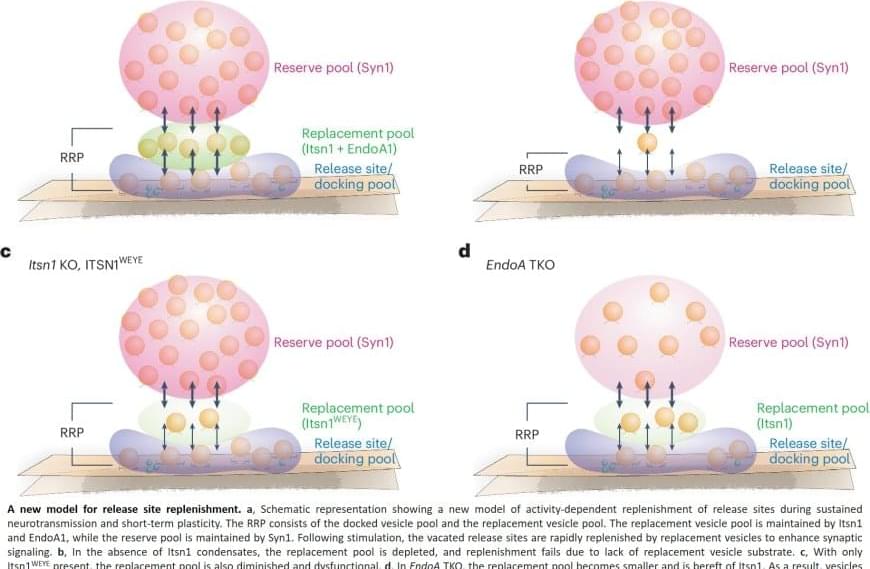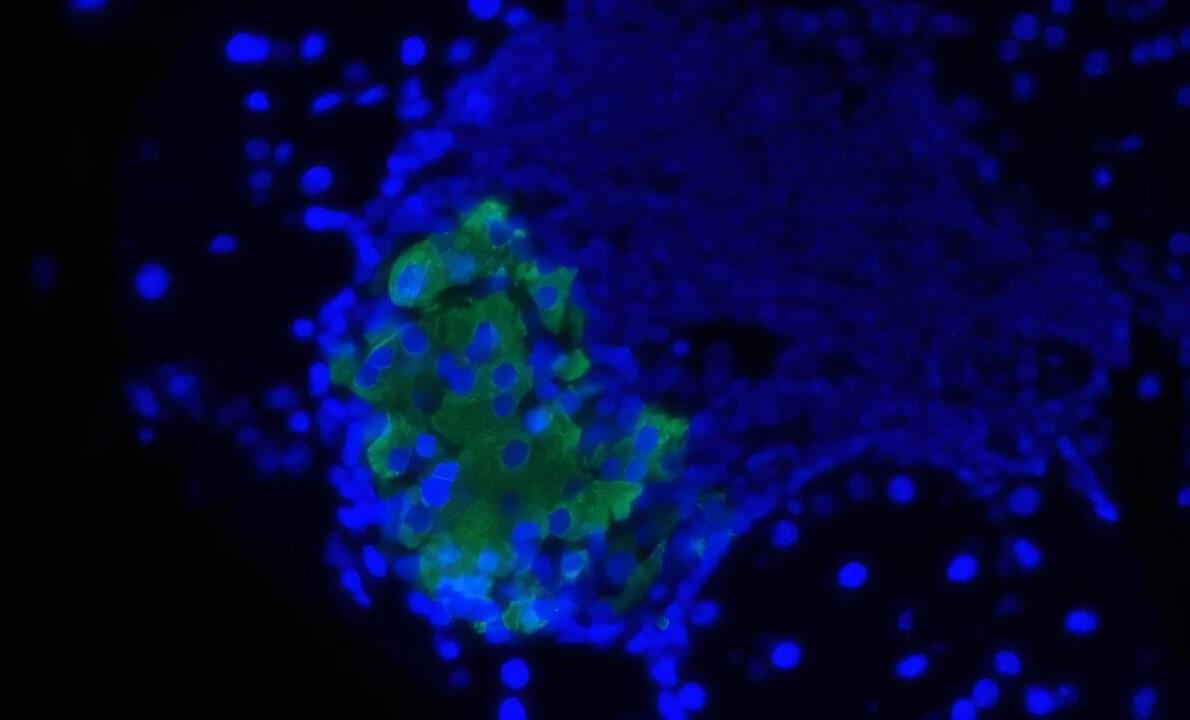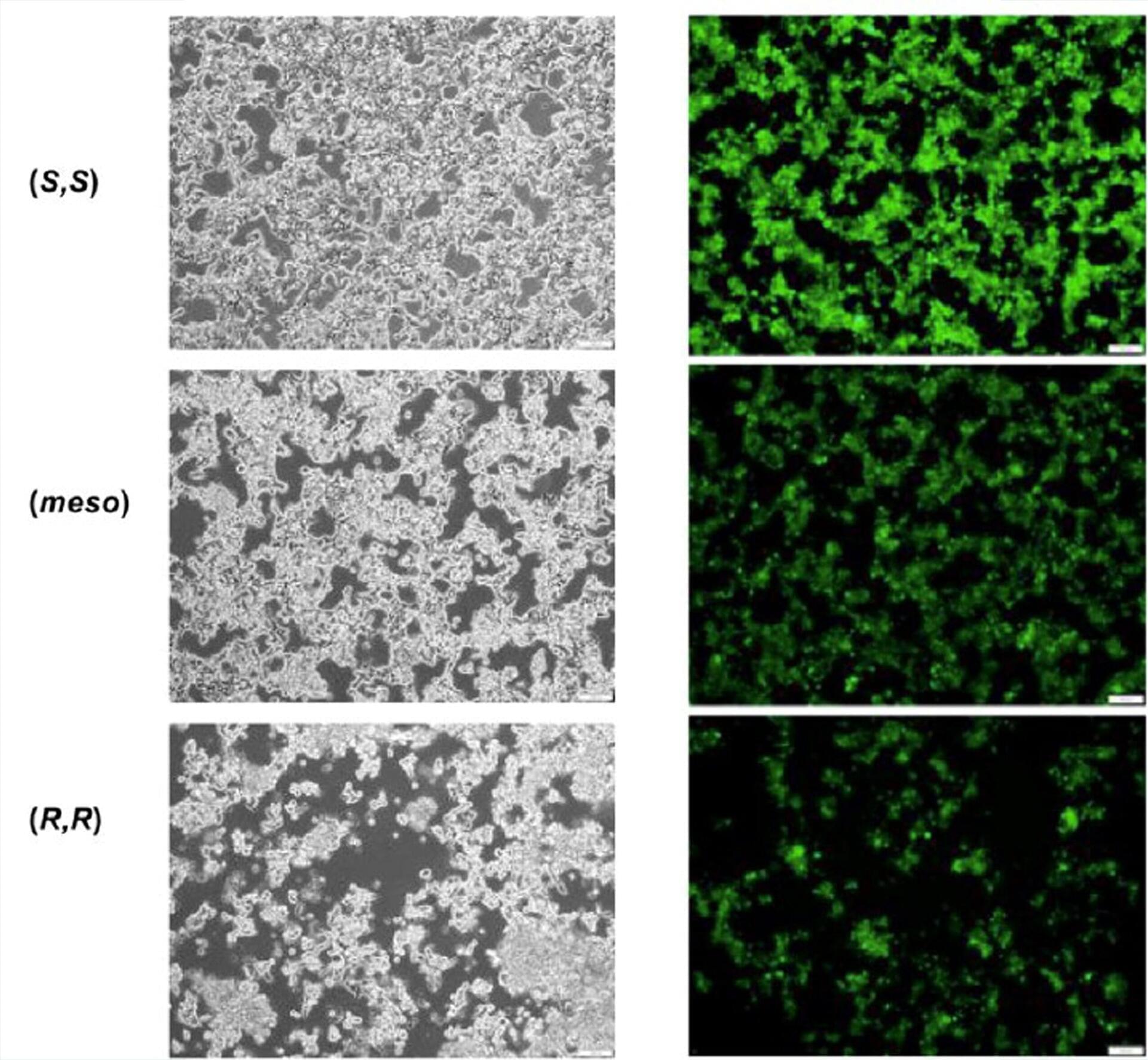Scientists cut E. coli’s genetic code from 64 to 57 codons—creating a powerful platform for synthetic biology breakthroughs.



Message transfer from brain cell to brain cell is key to information processing, learning and forming memories. The bubbles, synaptic vesicles, are housed within the synapse — the connection point where brain cells communicate. In typical synapses within the brains of mammals, 300 synaptic vesicles are clustered together in the intersection between any two brain cells, but only a few of these vesicles are used for such message transfer, researchers say. Pinpointing how a synapse knows which vesicles to use has long been a target of research by those who study the biology and chemistry of thought.
In an effort to better understand the operation of these synaptic vesicles, the team designed a study that first focused on endocytosis, a process in which brain cells recycle synaptic vesicles after they are used for neuronal communication.
Already aware of intersectin’s general role in endocytosis and neuronal communication, the scientists genetically engineered mice to lack the gene that codes for intersectin. However, and somewhat to their surprise, the lead says removing the protein did not appear to halt endocytosis in brain cells.
The research team refocused their experiments, taking a closer look at the synaptic vesicles themselves.
Using a high-resolution fluorescence microscope to observe where intersectin is in a synapse, the researchers found it in between vesicles that are used for neuronal communication and those that are not, as if they are physically separating the two.
To further understand the role of intersectin at this location, they used an electron microscope to visualize synaptic vesicles in action across one billionth of a meter. In all the nerve cells from mice lacking this protein, the scientists say synaptic vesicles close to the membrane were absent from the release zone of the synapse, the place where the bubbles would discharge to nearby neurons.
“This suggested that intersectin regulates release, rather than recycling, of these vesicles at this location of the synapse,” says the author.
Join us on Patreon! https://www.patreon.com/MichaelLustgartenPhD
Discount Links/Affiliates:
Blood testing (where I get the majority of my labs): https://www.ultalabtests.com/partners/michaellustgarten.
At-Home Metabolomics: https://www.iollo.com?ref=michael-lustgarten.
Use Code: CONQUERAGING At Checkout.
Clearly Filtered Water Filter: https://get.aspr.app/SHoPY
Epigenetic, Telomere Testing: https://trudiagnostic.com/?irclickid=U-s3Ii2r7xyIU-LSYLyQdQ6…M0&irgwc=1
Use Code: CONQUERAGING
NAD+ Quantification: https://www.jinfiniti.com/intracellular-nad-test/

As we age, our bodies gradually lose their ability to repair and regenerate. Stem cells diminish, making it increasingly difficult for tissues to heal and maintain balance. This reduction in stem cells is a hallmark of aging and a key driver of age-related diseases. Scientists have long debated whether this decline is the root cause of aging or a side effect. Efforts to use stem cell transplants to reverse aging have faced many challenges, such as ensuring the cells survive and integrate into the body without causing serious side effects, like tumors.
In a recent study published in Cell, researchers from the Chinese Academy of Sciences and Capital Medical University introduced a new type of human stem cell called senescence-resistant mesenchymal progenitor cells (SRCs) by reprogramming the genetic pathways associated with longevity. These cells, which resist aging and stress without developing tumors, were tested on elderly crab-eating macaques, which share physiological similarities with humans in their 60s and 70s.
The research team conducted a 44-week experiment on these macaques. The macaques received biweekly intravenous injections of SRCs, with a dosage of 2×106 cells per kilogram of body weight. The researchers found no adverse effects among the macaques. Detailed assessments confirmed that the transplanted cells did not cause tissue damage or tumors.
The researchers discovered that SRCs triggered a multi-system rejuvenation, reversing key markers of aging across 10 major physiological systems and 61 different tissue types. The treated macaques exhibited improved cognitive function, and tissue analyses indicated a reduction in age-related degenerative conditions such as brain atrophy, osteoporosis, fibrosis, and lipid buildup. 👍
We developed a robust epigenetic clock to estimate age from two wild polar bear subpopulations using blood samples. There was a correlation between epigenetic (DNAm) and chronological age throughout the polar bear lifespan. Polar bears in the wild have a lifespan of approximately 25 years (Rode and Stirling 2018), thus the clock estimates age to ±3% of the polar bear lifespan, although we caution that age estimates may be less accurate for older individuals. Advantages to this method include obtaining more accurate age estimates compared to cementum annuli-derived ages and leveraging samples likely already routinely collected (e.g., blood, tissue) during capture, as opposed to pulling teeth. Further, archived samples or previously extracted DNA may be used for DNAm analysis, extending the value of existing samples and saving money on DNA extraction costs. Our results complement other polar bear clocks (Newediuk et al. 2024, 2025) and provide additional support for the use of DNAm methods to estimate the age of wild mammals (De Paoli-Iseppi et al. 2017).
Our DNAm method estimates polar bear age with a MAE of 0.75 years. In contrast, accuracy of cementum annuli for aging polar bears to within 1 year of actual age has ranged from 32% to 75% (Calvert and Ramsay 1998 ; Christensen-Dalsgaard et al. 2010 ; Hensel and Sorensen 1980). Cementum annuli age estimates are less accurate when made by less experienced observers (Christensen-Dalsgaard et al. 2010 ; Hensel and Sorensen 1980 ; McLaughlin et al. 1990) and can vary between laboratories by 10 years (Christensen-Dalsgaard et al. 2010). For example, in one lab, multiple female polar bears were aged at ~10 years, while a second laboratory aged them at 20 years old (Christensen-Dalsgaard et al. 2010). Our method removes these sources of error. We do, however, acknowledge a potential source of technical error, given that all but three of the tooth-aged samples were run on one plate, and the majority of our known age samples were run on another plate.
The ER-100 drug candidate reverses aging in mice, and David Sinclair says human trials start soon. Is this a magic pill for aging? Dr. Aubrey de Grey discusses the latest advances in life-extension research.
Our story begins on X, where user “rand_longevity” wrote, “Aging will be reversible in humans within 8 years”, to which Dr. David Sinclair replied, “8 years? After successful non-human primate trials, human age reversal trials are set to begin in 6 months”, later naming the ER-100 drug candidate.
Life Biosciences ER-100 drug candidate leverages partial epigenetic programming using 3 of the 4 Yamanaka factors to promote cellular rejuvenation to a younger state without the loss of cell identity. They believe this will help prevent or reverse age-related diseases at a root level — but they’re not the only organization pursuing life-extension research.
Dr. de Grey’s own research has focused primarily on accumulated side effects from metabolism, embodied in the title of his 1999 book, “The Mitochondrial Free Radical Theory of Aging”.
Dr. de Grey is well-known as one of the top gerontology and life-extension scientists in the world, and his own work has also been successful in extending the lifespan of lab animals. In this program, he discusses his work and some of the key elements of living a longer, healthier life.
DISCLAIMER: This program is a discussion is about ongoing scientific research, and is NOT providing medical advice. Please consult your doctor before starting any supplements, beginning an exercise routine, or undertaking lifestyle changes.

Scientific breakthroughs in one disease don’t always shed light on treating other diseases. But that’s been the surprising journey of one Mayo Clinic research team. After identifying a sugar molecule that cancer cells use on their surfaces to hide from the immune system, the researchers have found the same molecule may eventually help in the treatment of type 1 diabetes, once known as juvenile diabetes.
Type 1 diabetes is a chronic autoimmune condition in which the immune system errantly attacks pancreatic beta cells that produce insulin. The disease is caused by genetic and other factors and affects an estimated 1.3 million people in the U.S.
In their studies, the Mayo Clinic researchers took a cancer mechanism and turned it on its head. Cancer cells use a variety of methods to evade immune response, including coating themselves in a sugar molecule known as sialic acid. The researchers found in a preclinical model of type 1 diabetes that it’s possible to dress up beta cells with the same sugar molecule, enabling the immune system to tolerate the cells.

The DNA of nearly all life on Earth contains many redundancies, and scientists have long wondered whether these redundancies served a purpose or if they were just leftovers from evolutionary processes. Both DNA and RNA contain codons, which are sequences of three nucleotides that either provide information about how to form a protein with a specific amino acid or tell the cell to stop (a stop signal) during protein synthesis.

A team from the Max-Planck-Institut für Kohlenforschung, Hokkaido University, and Osaka University has discovered that subtle differences in molecular structure can have a major impact on the performance of mRNA-based drugs. Their findings, published in the Journal of the American Chemical Society, open the door to the development of safer and more effective vaccines and therapies.
To deliver therapeutic nucleic acids like mRNA into cells, scientists rely on lipid nanoparticles (LNPs)—tiny, fat-based carriers that protect fragile genetic material, enabling it to survive in the body and reach target cells. A key component of these LNPs are ionizable lipids, which help mRNA enter cells and then release it effectively. One such lipid, ALC-315, was notably used in the Pfizer/BioNTech COVID-19 vaccine, a medical breakthrough that played a critical role in controlling the global pandemic.

Background: Extramammary Paget’s disease (EMPD) is a rare intraepithelial adenocarcinoma that occurs in the genitals, axilla, and anus, where apocrine sweat glands are abundant. This disease is mainly characterized by localized lesions and rare distant metastasis. Scrotal Paget’s disease is a rare type of EMPD, and there is no standard treatment for metastatic EMPD.
Case Description: Here, we reported the genetic results of a patient with a PIK3CA gene mutation in scrotal Paget’s disease who developed multiple metastases to the lymph nodes, liver, and bones during adjuvant radiotherapy, as well as the results of treatment with a PIK3CA inhibitor. The latest advances in this field were also summarized. The treatment response was evaluated as stable disease (SD) after 6 courses of docetaxel plus tegafur (DS regimen) chemotherapy. Then, a second-line treatment, a PIK3CA inhibitor, WX390, was administered with tolerable toxicity. There was a treatment-induced increase in blood glucose level during treatment, and insulin was administrated with good control. The progression-free survival (PFS) was 3.9 months and the overall survival (OS) was 16 months.
Conclusions: PIK3CA is a commonly mutated gene in EMPD. To the best of our knowledge, this is the first case report of a PIK3CA inhibitor for the treatment of primary metastatic EMPD, and the treatment efficacy was good. PIK3CA inhibitors may be promising for the treatment of metastatic EMPD in the future.